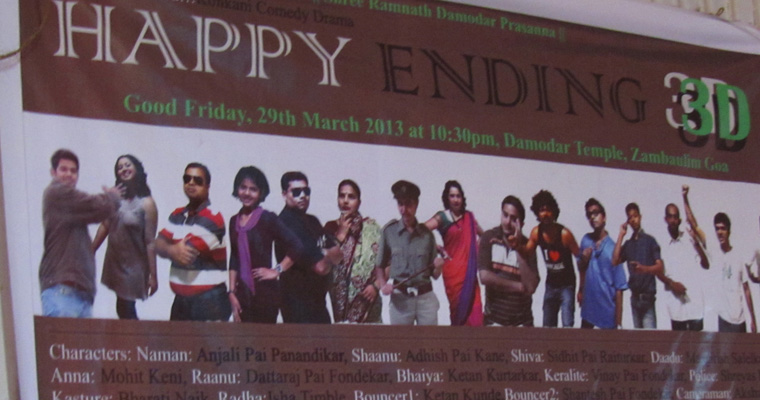Risque theatre in a Goan village
From behind the curtains of the tiny stage set up at one end of the outer hall of the Zambaulim temple comes an announcement ― “Saish Panandikar presents a one and half act play – Happy Ending 3D.” A cheer goes up from the audience of women and children sitting jam-packed on the floor of the hall. The men are crowding around, munching into the ladoos that are being freely distributed. Hugs and backslapping resounds as old friends meet. You can hear the actors and theatre crew jostle for space in the cramped wings of the stage. An invocation for blessings is made―”May all our 33 crore Gods bless us. And may all the Gods of all other faiths bless us too!”
The curtain part and an attractive woman played by Anjali Panandikar sets the stage aglow. The Shigmotsav festival is on at Zambaulim. This is a celebration of Holi which will host comedy dramas, colour throwing revelry, festive stalls and bawdy entertainment for the hordes of Margao citizens who converge here for Shigmo celebrations. Goa Streets Editor José Lourenço was there, chatting with Saish Panandikar, aka Sai, the writer of the ‘risquiest’ play of the festival―Happy Ending 3D.In this comic farce, members of a family conspire to kidnap a wealthy mama (maternal uncle)for personal gain.
JL: Sai, tell us something about the Zambaulim temple. Why do Margao people flock to Zambaulim for this festival?
SP: When the Portuguese began converting Hindus and demolishing temples in Margao in the 1560s, the linga idol of Lord Damodar (popularly known as Dam-bab) was secretly removed and kept overnight at a house in Comba, of the Keni family. Then it was moved out of Margao and eventually was shifted to Zambaulim village, which was outside of Portuguese control.
On the first day of the festival, the Hardaspann ritual, depicting the Ramayana, is carried out at Margao. A ritual coconut is consecrated (naal dovorop) at the Keni house in Margao, which had acted as a temporary overnight refuge for the Damodar deity before being moved out of Margao.
Strangely, the Hardaspann prayer ritual is carried out in Kannada, the language of Karnataka. My theory is that in those times, the Dam-bab idol was taken by some families from Margao to neighbouring Karnataka and brought back to Zambaulim after some generations.
The climax scene from’Happy Ending 3D
.
JL: How did these Shigmo plays begin? How many plays are staged during the Shigmotsav?
SP: I am told that the natak was being staged even in my great grandfather’s time. I began acting in these plays as a kid, playing roles like that of little Sambhaji, the son of Shivaji. In 1982 I began to involve myself more actively in these plays. The plays are staged every night from Friday to Monday, of the Shigmotsav festival. On Tuesday the Gulal takes place, where all the Margao people gather here and celebrate Holi. In the 1990s I began writing plays for the Zambaulim Shigmo, and since then every year I have been staging the Friday play of the Shigmo.
In the early years only men were allowed to act in these plays, they would play the female roles too. It was only in the 1970s that a female actor took part in the Shigmo play for the first time, in a play by the Shinkre group.
During the Zambaulim Shigmo, the idol of Lord Damodar is brought up and placed at the first floor gallery which surrounds the hall (sabhamandap) on the ground floor. It is as though Dam-bab himself has come to watch the plays staged by his devotees, the Madgaunkars.
JL: What happens at this event called ‘Okol Novro’ during Gulal festivities?
SP: The Okol-Novro tradition is to get a mock groom and bride up on a stage called the Ramnath stage and then have a lot of fun by cracking jokes, using raunchy language and sexy humour. In my grandfather’s time, a bridal pair and a funeral procession would take place at the same time on stage, and they would meet, as a parody of life. Obscenities are merrily exchanged between characters on stage and off stage. It is a kind of aggressive release and cleansing. For me, Shigmo is a festival when people should release all their bad thoughts and anger, and clean themselves. So in my plays I allowed that free expression and release.
JL: The play is like a large family get-together as well as a broader satirical social commentary. There is realism combined with hearty dashes of absurdism and of course large doses of naughty, sexy humour. Considering there are a lot of women and children watching, isn’t there some kind of censorship for these plays? The next day’s play by a different group is titled Xezarchi Bail Gostachi (The Neighbour’s Wife is Desirable) !
SP: There is no censorship for these plays. There is no need to get the script approved or anything. These plays may be naughty, but they are accepted by our community for this festival time. We never cross the line. Our intention is not to malign or hurt anybody. This is just our community sharing some jokes and having a good time. This play is staged only for the Zambaulim Shigmo. If I were to stage it anywhere else, I would have to adapt it appropriately for a wider audience.
JL: Prominent characters in Goa, and particularly of Margao, become the butt of merry jokes in the play script. Manohar Parrikar, Digambar Kamat, Vijay Sardesai, Aires Rodrigues, Sridhar Kamat, Vaikunt Pai Fondekar are favourite targets of Saish’s nataks. Don’t the real people referred to in the comedy of the play get angry?
SP: No no, they take it all in stride. We had a record crowd, around 600, for this year’s play. The elders say they never saw so many people attend and stay on till the end. There were people even watching from the upper gallery.
JL: This is a very avant-garde thing, staging a risqué drama right inside the temple, under the deity’s very nose. It is radical and yet traditional. It is very broadminded and progressive, contrary to what the general public would think of conservative Hindu society.
Saish Panandikar – writer of the play ‘Happy Ending 3D’
.
SP: Though the play itself is progressive, there are some unfortunate conditions that we have to follow. At the Zambaulim Shigmo plays, only actors from the Brahmin and Vani (merchant caste) can perform on the stage inside the temple. I feel bad that some of my good actor friends from other communities cannot act here. But we hope to reform this. Now with Bhai Naik being the President of the Mathagramasth Hindu Sabha, who is also the president of an educational trust, we hope change will come.
JL: How does the Shigmo natak compare to khell, the traditional Konkani street play?
SP: Khell street plays would take place during Portuguese rule and even in pre-colonial times. The khell actors would criticize and hurl abuses at the colonial regime in the plays which would be staged during Intruz, the three days before the 40-day Lent period. They would be invited to perform even in front of the village Regedor’s (local authority) house. The authorities would allow it as a kind of social release valve, to let people express their pent up frustrations and anger during Intruz. So these Shigmo plays also act like a kind of release valve once a year.
I come from a background of street theatre which we used to stage during our years with the PSU- Progressive Students Union. I continued to use that style in these nataks. I don’t use many props or costume changes. My play Happy Ending occurs in the period of one night. So there is no need for costume changes or set changes.
For me, props and costumes are not important. I prefer direct conversation, eye-to-eye contact with the audience rather than between characters. I believe theatre should focus on story, dialogues and characters. I want to stimulate the audience to imagine and think, so that the play becomes more interactive, rather than spoon feeding them with lavish sets and costumes.
JL: Do these plays nurture new actors?
SP: Yes, of course. New actors like Ketan Kurtarkar, Mohit Keni, Manguirish Salelkar and Esha Timble have acted in my play. Esha has stepped on stage for the Shigmo play for the first time this year. The cast also includes Anjali Panandikar, Adish Kane, Medha Kamat, Shreyas Kamat, Bharti Naik and others.
JL: Have you ever received any reaction from Hindu right-wing groups?
SP: We were always an activist and reformist group. So there was always opposition from some elements. Even when I wrote some episodes for Prudent Media’s program ‘Lokshahi Hai Hai’, I received phone calls and was met by some persons who criticized me for making fun of our Gods. I replied saying I had a right to express myself and that this was the right thing for me to do.
JL: How are these risqué plays with double-entendre received by the audience in the temple? Your jokes and the message at the end of the play are laced with sexual slang and double meaning. Do you write for two parallel audiences – those who do and those who don’t get the jokes?
SP: Actually all people like this. People think some things are taboo. They want to think and talk about them, but not openly. So I use this platform to entertain and educate them, and also provide them with some erotic mischief! I give them the unexpected; shock them a bit with outteponn, crackpot stuff!
JL: Lala Bala is a legendary open-air bar just outside the temple premises. Men gather there after the plays, or during them, for a drink and camaraderie late into the night. How did this place become so talked about among Madganvkars?
SP: Lala and Bala were two brothers. That’s a good place to recharge and relax. A visit to Lala Bala is an important part of the Shigmo experience for some men. There is a Kushavati rivulet near the temple, called Pantto, parents like to take their kids for a dip there. For them the Pantto is Dam-bab. For others, it is a ritual to attend the plays. For yet others, serving meals to devotees in the temple is the real ritual. Some don’t even enter the temple, Lala Bala is their temple.
JL: At the end of the play, there is a moral message. Happy Ending in risqué slang means to be given erotic release manually at the end of a massage, isn’t it? How did you get away with that!
SP: The message is that everyone wants someone else to come and change their world. You can change the world yourself, you don’t have to wait for some Mama or Baba or Bhai or Tai to do it for you. You shouldn’t wait for someone else to give you a happy ending. The hard work and action of your own hands is most powerful for a Happy Ending!
.
.
.






